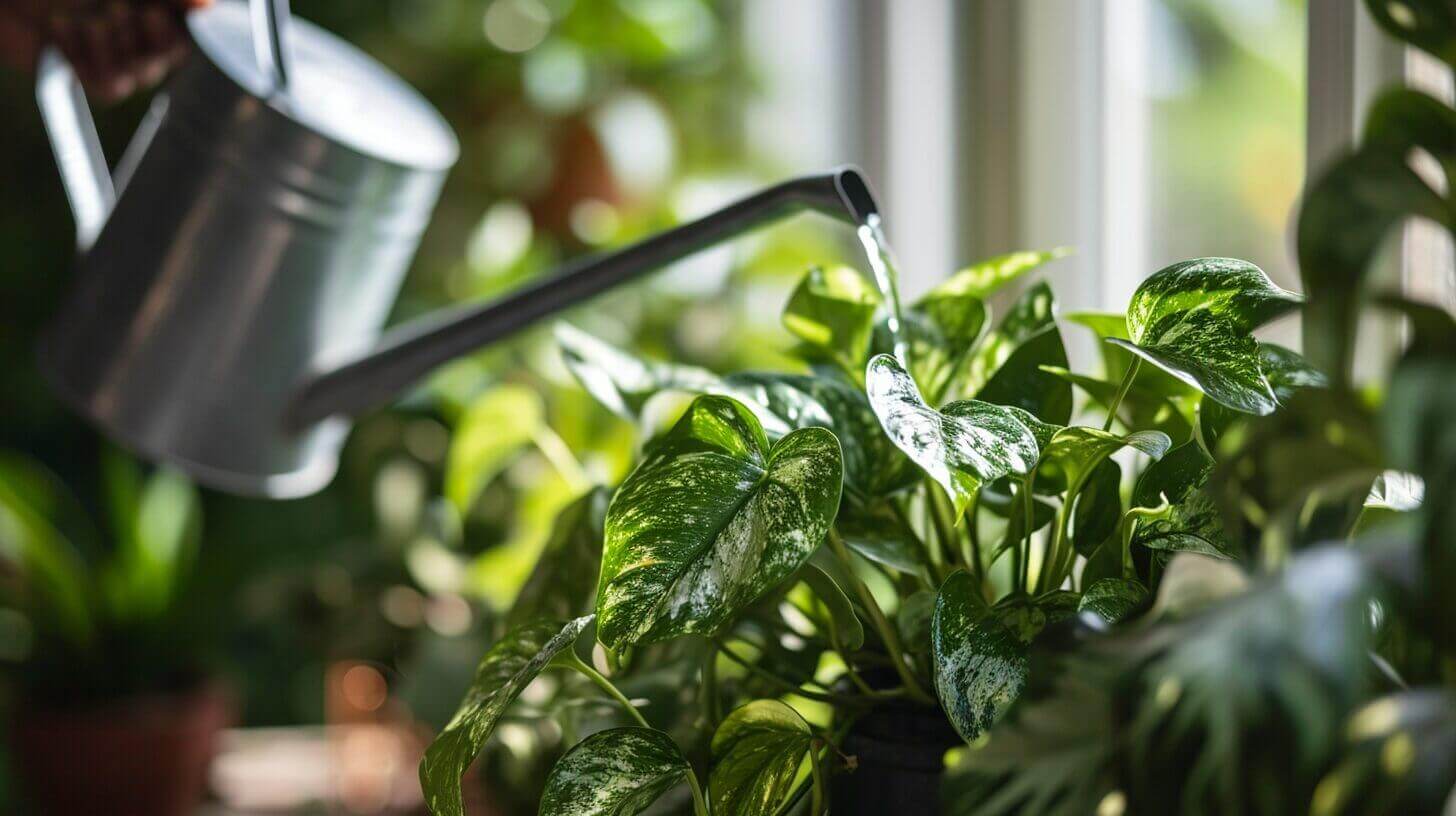How Often to Water Pothos Plant: Tips for Proper Pothos Watering
In the world of plant care, finding the perfect balance is key. Just like a delicate dance, knowing how often to water your pothos plant can help it thrive and flourish.
This article aims to provide you with valuable tips for proper watering, ensuring your pothos receives the ideal amount of moisture. By understanding the signs of overwatering and underwatering, considering various factors, and implementing best practices, you can establish a watering schedule that fosters a sense of belonging between you and your green companion.
Key Takeaways
- Pothos plants prefer slightly moist soil, but not waterlogged conditions.
- Overwatering can lead to root rot and other issues.
- Underwatering can cause wilting and yellowing of leaves.
- Factors such as humidity levels and pot size influence the frequency of watering.
Understanding How Often To Water Pothos Plant
The understanding of the watering needs of Pothos is crucial for maintaining the health and vitality of these popular houseplants. Proper watering techniques are essential to ensure that the Pothos plant thrives and remains healthy.
One common mistake that many people make is overwatering their Pothos. These plants prefer slightly moist soil, but they do not like to sit in waterlogged conditions. Overwatering can lead to root rot and other issues that can harm the plant. To avoid this, it is important to allow the top inch of soil to dry out before watering again.
Another common mistake is underwatering the Pothos plant. While these plants are fairly low-maintenance, they do require regular watering. Underwatering can cause the leaves to wilt and turn yellow, so it is important to monitor the moisture levels of the soil. To ensure proper watering, it is recommended to water the Pothos thoroughly, allowing the excess water to drain out completely.
It is also important to consider the environmental conditions in which the plant is situated, such as temperature and humidity, as these factors can affect the watering needs of the Pothos plant.
Signs of Overwatering and Underwatering in Pothos
Frequently overlooked, signs of overwatering and underwatering in Pothos can be easily identified by observing the condition of the leaves and the moisture level of the soil. Overwatering is one of the most common mistakes made by Pothos owners. The leaves of an overwatered plant will appear yellowish, wilted, and may even develop brown spots. The soil will be constantly wet and may have a foul smell.
On the other hand, underwatering Pothos can lead to dry, crispy leaves that may turn brown and fall off. The soil will be dry to the touch and may pull away from the edges of the pot.
Preventing water-related issues in Pothos is crucial for the plant’s health and vitality. To avoid overwatering, it is important to allow the top inch of soil to dry out before watering again. Use well-draining soil and ensure that the pot has drainage holes to allow excess water to escape.
On the other hand, underwatering can be prevented by checking the soil regularly and watering when it feels dry to the touch. It is important to provide enough water for the soil to be evenly moist, but not saturated.
Factors to Consider When Determining Pothos Watering
When determining watering frequency for Pothos, it is essential to consider factors such as humidity levels, pot size, and the specific needs of the plant. Proper watering is crucial for the health and growth of Pothos plants, as both overwatering and underwatering can be detrimental. Here are four factors to consider when determining watering frequency for Pothos:
- Humidity levels: Pothos plants thrive in environments with moderate to high humidity. If you live in a dry climate or have low humidity indoors, you may need to water your Pothos more frequently to compensate for the lack of moisture in the air.
- Pot size: The size of the pot in which your Pothos is planted can affect how often you should water it. Smaller pots tend to dry out more quickly, requiring more frequent watering, while larger pots retain moisture for longer periods.
- Specific needs of the plant: Different Pothos varieties may have slightly different watering requirements. Some varieties prefer slightly drier soil, while others thrive in consistently moist conditions. Research the specific needs of your Pothos variety to determine the best watering schedule.
- Importance of soil moisture: One of the most important factors to consider when determining watering frequency is the moisture level of the soil. Before watering, check the moisture level by sticking your finger into the soil up to your first knuckle. If the soil feels dry, it’s time to water your Pothos.
Best Practices for Watering A Pothos Plants
To ensure optimal hydration for Pothos plants, it is crucial to implement best practices for watering. One of the most common mistakes when it comes to watering Pothos plants is overwatering. Pothos plants prefer slightly dry conditions, so it is important to allow the top inch of soil to dry out between waterings.
Another mistake to avoid is underwatering. While Pothos plants are relatively drought-tolerant, they still require regular watering. A good technique is to water thoroughly until water drains out of the bottom of the pot, and then allow the excess water to drain away. This helps prevent waterlogging and root rot.
In terms of frequency, it is best to water Pothos plants when the top inch of soil feels dry to the touch. However, this can vary depending on factors like humidity levels and pot size. In dry climates or smaller pots, more frequent watering may be necessary. On the other hand, in humid climates or larger pots, less frequent watering may be sufficient.
How to Establish a Watering Schedule for Pothos Need
Implementing a systematic watering schedule for Pothos plants is essential in order to maintain their health and vitality. Pothos, also known as Devil’s Ivy, is a popular houseplant due to its attractive trailing vines and ability to thrive in various light conditions. However, improper watering can lead to root rot or dehydration, causing the plant to suffer.
To establish a proper watering routine for Pothos, consider the following:
- Evaluate soil moisture levels: Before watering, check the moisture level of the soil. Stick your finger about an inch deep into the soil; if it feels dry, it’s time to water.
- Water thoroughly but infrequently: Pothos prefer a thorough watering to ensure the entire root ball is moistened. Water the plant until it begins to flow out of the drainage holes, then allow the soil to dry out before watering again.
- Adjust watering frequency based on environmental factors: Factors such as temperature, humidity, and light levels can influence how quickly the soil dries out. In warmer, drier conditions, you may need to water more frequently, while in cooler, more humid environments, less frequent watering may be necessary.
- Observe the plant’s response: Keep an eye on your Pothos to ensure it is thriving. If the leaves appear droopy or wilted, it may indicate over or under watering. Adjust the watering schedule accordingly to maintain optimal soil moisture levels.
Frequently Asked Questions
Will Proper Watering Help Revive Pothos Leaves that are Drooping?
Proper watering is the key treatment for drooping pothos leaves. When the leaves of your pothos plant start to droop, it is often a sign of underwatering or overwatering. To revive drooping pothos leaves, ensure you water the plant evenly, allowing the soil to dry out slightly between waterings.
Will Proper Watering Help Pothos Plants Grow Faster?
Proper watering can enhance pothos growth rate. Adequate hydration ensures that nutrients are efficiently absorbed, supporting faster growth. Pothos plants thrive in slightly moist soil, so watering when the top inch feels dry helps maintain optimal moisture levels. However, overwatering can lead to root rot, so finding the right balance is crucial for promoting healthy and expedited growth.
How Does Overwatering or Underwatering Affect the Need for Repotting a Pothos Plant?
Overwatering or underwatering greatly impacts the significance of repotting your pothos plant. When overwatering occurs, the excess moisture can lead to root rot, making repotting necessary to promote healthy growth. Conversely, underwatering may weaken the plant and hinder its development, prompting the need for repotting to provide fresh nutrients and space for the roots to expand.
Can I Use Tap Water to Water My Pothos Houseplant?
Using tap water to water your pothos plant has both pros and cons.
The main advantage is convenience, as tap water is readily available.
However, tap water often contains chemicals such as chlorine and fluoride, which can be harmful to pothos plants.
To treat tap water for pothos plants, it is recommended to let the water sit for 24 hours to allow the chlorine to dissipate.
Alternatively, you can use filtered or distilled water to ensure the health of your pothos plant.
How Often Should I Fertilize My Pothos Plant?
Fertilizing your pothos plant is an important aspect of its care. To determine the frequency of fertilization, consider the type of fertilizer you are using. Generally, it is recommended to fertilize pothos plants every 2-4 weeks during the growing season. However, it is crucial to follow the instructions provided by the fertilizer manufacturer for the specific product you are using.
Some popular fertilizers for pothos include balanced liquid fertilizers and slow-release granular fertilizers. These provide the necessary nutrients for healthy growth and vibrant foliage.
How often should I water my Pothos plant?
The frequency of watering your Pothos plant depends on various factors such as the temperature, humidity levels, and the size of the pot. As a general rule, you should water your Pothos plant when the top inch of the soil feels dry.
What is the best way to water a Pothos plant?
The best way to water a Pothos plant is by bottom watering. Simply place the pot in a saucer filled with water and let the roots absorb the water from the bottom. This method prevents overwatering and ensures the plant gets the right amount of water.
How often should you water an indoor Pothos plant?
Indoor Pothos plants generally require watering every 7-10 days. However, it is important to monitor the soil moisture levels and adjust the watering frequency accordingly.
How much water does a Pothos plant need when it is newly planted?
When you first plant a Pothos, you’ll need to water it thoroughly to help establish its roots. Give your new Pothos plant enough water to thoroughly moisten the soil.
Can I use tap water to water my Pothos plant?
Yes, you can use tap water to water your Pothos plant. However, it is recommended to let the tap water sit overnight to allow chlorine to evaporate and then use it to water your plant.
What should I do if my Pothos plant needs more water?
If your Pothos plant needs more water, you can increase the frequency of watering or water it slightly more. Monitor the soil moisture levels and adjust accordingly to avoid overwatering.
Do Pothos Plants Require More or Less Water if They Have Drainage Holes in the Pot?
Drainage for Pothos is essential in maintaining the correct amount of water. With drainage holes in the pot, excess water can easily escape, preventing overwatering. This ensures that Pothos plants receive the right balance of moisture, preventing root rot and promoting healthy growth. Thus, drainage holes in the pot lead to less water accumulation and better plant health.
Is top watering or bottom watering better for Pothos plants?
Bottom watering is generally better for Pothos plants as it helps prevent overwatering and keeps the soil moist without making it soggy. However, if the plant is heavily pot-bound, you can also top water to ensure all the roots receive moisture.
What is the proper watering routine for Pothos plants?
The proper watering routine for Pothos plants involves checking the soil’s moisture level regularly and watering when the top inch of the soil feels dry. Remember to adjust the watering frequency based on the plant’s needs and environmental conditions.







